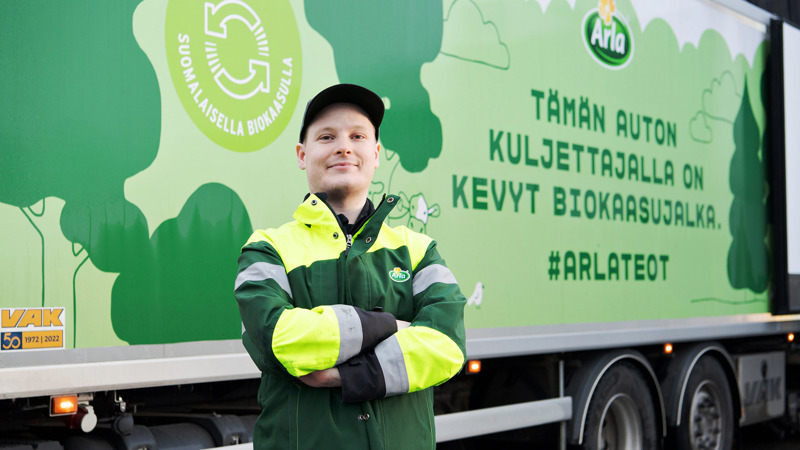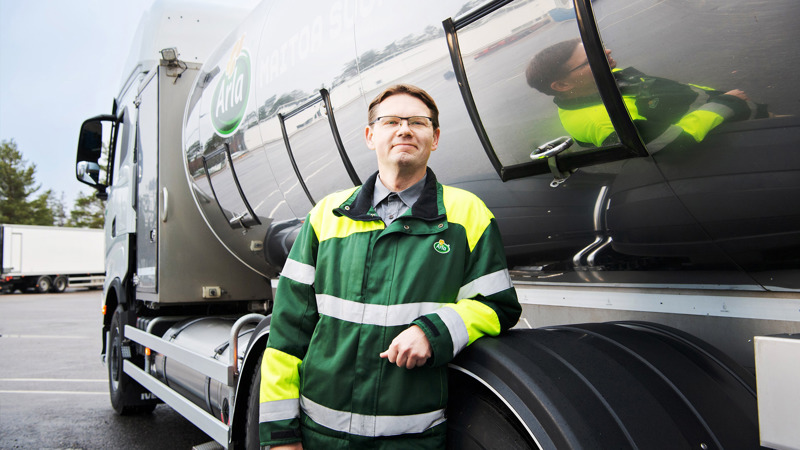Arla’s dairy products go by biogas from farms to dairy and from dairy to stores
Biogas vehicles have been used to deliver Arla products in Finland since 2019. Now also milk collection has switched to the biogas age with the first gas-driven milk tanker starting operations.
“The good points of gas vehicles are that they produce less emissions and biogas is a cheaper fuel than diesel,” says Otto Ahola, distribution team leader at Arla.
Arla has four product delivery vehicles running on renewable biogas, and the plan is to acquire more once the leasing agreements on their diesel vehicles expire.
The delivery routes operated by gas vehicles go from the Sipoo dairy to wholesalers and stores in the Uusimaa region. Since there are several gas filling stations on the routes, refueling doesn’t mean extra twists and turns.
“Although delivery driving is quite heavy on fuel, one tankful is enough for more than 400 km. Delivery vehicles drive trips of around 100-150 km each day, which means it’s enough to refuel every other or third day,” Ahola explains.

Photo: Otto Ahola, distribution team leader at Arla, also drives on biogas when not working.
Quiet running suits night deliveries
Otto Ahola says that drivers have a positive attitude to gas vehicles.
“Gas vehicles work just like any other trucks, except they make less noise. That’s a good thing, since deliveries take place at night and early morning.”
Ahola says there is only a marginal difference in the purchase price of a delivery vehicle running on compressed gas compared to a diesel vehicle.
“A gas truck is only some percent more expensive than a diesel one. We’ve also benefited from the government’s purchase subsidy.”
A milk tanker running on biogas sets a good example
Arla started to use their first LBG milk collection tanker in November 2022 to collect milk from farms in Southern Finland.
Robert Sandström, Milk Acq.- and Logistics Manager, at Arla, is eagerly awaiting the first experiences of the biogas tanker.
“The average driving range promised is more than a thousand kilometers, but the tanker idles at milk farms, which reduces this. The load also makes a difference and consumption is higher when driving with a full load. Practice will show how far the tanker can run on a full tank. For us, 700 kilometers would do,” Sandström says.
Arla’s other milk collection tankers are owned by transport operators. Arla requires their partners to be prepared to switch to non-fossil fuels where possible.
“Gas vehicles are part of our future strategy. We want our own example to show the way for transport operators,” Sandström says.

Photo: ”Use of biogas is a competitive edge and an effortless solution to reach emissions ambitions,” says Robert Sandström, Milk Acq.- and Logistics Manager at Arla.
Significant emissions reduction with biogas
Arla’s ambition is to reduce greenhouse gas emissions in their own operations by 63% and in direct emissions by 30% by 2030.
Since greenhouse gas emissions are up to 90% less than a vehicle using fossil fuel, biogas has a huge role in reducing emissions in the logistics sector.
There is a willingness to switch to biogas. However, long distances and heavy loads still impose their own limitations.
“Since we have farms across Finland, distances are long. There are not yet filling stations everywhere in Finland and this is the biggest limiting factor,” Sandström says. He certainly hopes that the network of filling stations will continue to expand.
Heavy loads also pose their own requirements.
”Since the power of the gas trucks currently available is still not enough for the largest weight category, the truck cannot carry as heavy payloads as required.”
However, in the near future, truck manufacturers will have gas vehicles with more powerful engines than at present and this will enable the transportation of increasingly heavier loads.
Biogas from own farms going forward
In the near future, it will perhaps be possible to use biogas produced on our own farms to transport Arla’s milk and dairy products. The idea behind this is to recover all the energy produced on farms and to use it.
“A lot of biomass is created on farms, and this could be used in biogas production. This could even be a revenue source for farms,” Robert Sandström envisions.
There are projects underway at Arla’s dairy farms to build their own biogas plants.
“A project at one farm is already at the permit stage and within a year may have its own gas reactor and filling station;” Sandström says.
Is your business seeking a way to a cleaner future?
Contact us and we'll tell you more about the possibilities in gas logistics.
